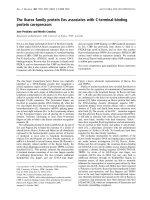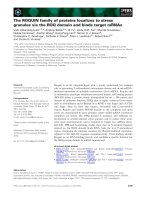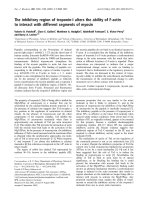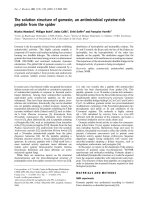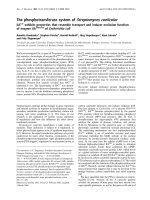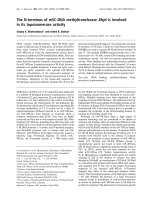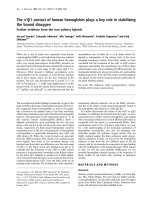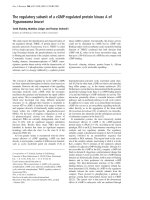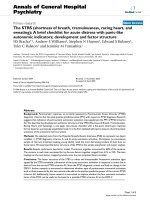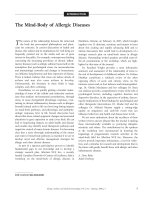Báo cáo y học: "The Groucho/TLE/Grg family of transcriptional co-repressors" pps
Bạn đang xem bản rút gọn của tài liệu. Xem và tải ngay bản đầy đủ của tài liệu tại đây (151.6 KB, 7 trang )
Genome
BBiioollooggyy
2008,
99::
205
Protein family review
TThhee GGrroouucchhoo//TTLLEE//GGrrgg ffaammiillyy ooff ttrraannssccrriippttiioonnaall ccoo rreepprreessssoorrss
Barbara H Jennings and David Ish-Horowicz
Address: Developmental Genetics Laboratory, Cancer Research UK, Lincoln’s Inn Fields, London, WC2A 3PX, UK.
Correspondence: David Ish-Horowicz. Email:
SSuummmmaarryy
The
Drosophila
Groucho (Gro) protein was the founding member of the family of transcriptional
co-repressor proteins that now includes the transducin-like enhancer of split (TLE) and Gro-
related gene (Grg) proteins in vertebrates. Gro family proteins do not bind DNA directly, but are
recruited by a diverse profile of transcription factors, including members of the Hes, Runx, Nkx,
LEF1/Tcf, Pax, Six and c-Myc families. The primary structure of Gro proteins includes five
identifiable regions, of which the most highly conserved are the amino-terminal glutamine-rich
Q domain and the carboxy-terminal WD-repeat domain. The Q domain contains two coiled-coil
motifs that facilitate oligomerization into tetramers and binding to some transcription factors.
The WD domain folds to form a β-propeller, which mediates protein-protein interactions. Many
transcription factors interact with the WD domain via a short peptide motif that falls into either
of two classes: WRPW and related tetrapeptides; and the ‘eh1’ motif (FxIxxIL). Gro family
proteins are broadly expressed during development and in the adult. They have essential functions
in many developmental pathways (including Notch and Wnt signaling) and are implicated in the
pathogenesis of some cancers. The molecular mechanisms through which Gro proteins act to
repress transcription are not yet well understood. It is becoming clear that Gro proteins have
different modes of action
in vivo
dependent on biological context and these include direct and
indirect modification of chromatin structure at target genes.
Published: 31 January 2008
Genome
BBiioollooggyy
2008,
99::
205 (doi:10.1186/gb-2008-9-1-205)
The electronic version of this article is the complete one and can be
found online at />© 2008 BioMed Central Ltd
GGeennee oorrggaanniizzaattiioonn aanndd eevvoolluuttiioonnaarryy hhiissttoorryy
The groucho (gro) gene family is found only in metazoa and
is named after the phenotype of the first identified mutation
in the family: gro
1
mutant Drosophila melanogaster display
clumps of extra bristles above the adult eyes that resemble
the distinctive bushy eyebrows of the American film star and
comedian Groucho Marx [1]. Subsequently, human
homologs were identified, but were named Transducin-Like
Enhancer of split (TLE) proteins because of apparent
structural similarities to β-transducin and the adjacency of
Drosophila gro to the Enhancer of split (E(spl)) complex
[2,3]. To complicate nomenclature further, when homologs
were first isolated from mouse, they were named Groucho-
related-gene (Grg) proteins [4], and the Caenorhabditis
elegans gro homolog is known as unc-37 [5]. TLE and Grg
have often been used interchangeably for vertebrate
orthologs in the literature and in sequence databases. For
simplicity, we shall use the term Gro proteins to refer to the
entire family.
Drosophila and C. elegans each contain a single Gro protein.
There are two in the tunicate Ciona, four in birds and
mammals, and six in teleost fish (Figure 1 and see also [6]).
It has been proposed that the evolution of the multiple Gro
proteins found in Chordata involved several independent
duplication events [6].
Despite the divergent names, Gro proteins show a great deal
of sequence conservation, especially in the carboxy-terminal
WD domain, where most share at least 86% amino-acid
identity (see Figure 1 and [6]). More sequence changes are
observed in the Q domains of these proteins. However, the
groupings of orthologs in a phylogenetic tree based on
Q-domain amino-acid sequence are essentially the same as
those based on the WD domain (Additional data file 1).
The carboxy-terminal WD domain of Drosophila and verte-
brate Gro proteins also shows significant conservation with
the WD domain of the yeast TUP1 co-repressor protein [7,8].
The sequences outside this region are very divergent,
however, so TUP1 is not generally considered a bona fide
member of the Gro family, although it probably represents
an ancestral form.
CChhaarraacctteerriissttiicc ssttrruuccttuurraall ffeeaattuurreess
The primary structure of Gro proteins includes five regions
defined by their evolutionary conservation: they are, in
order, Q, GP, CcN, SP and WD (Figure 2). The amino-
terminal Q domain and the carboxy-terminal WD-repeat
domain are the most highly conserved and rigorously
characterized features of this protein family.
Sequences within the glutamine-rich Q domain are predicted
to form two amphipathic α-helical motifs, referred to as AH1
and AH2, which facilitate oligomerization into tetramers and
binding to some transcription factors (for example, LEF1/
TCF, FoxA, c-Myc [9-11]).
The glycine/proline rich GP domain has been implicated in
the recruitment of histone deacetylases [12] and the central
CcN domain contains a nuclear localization signal and
potential regulatory phosphorylation sites [2]. Although the
role of the SP domain (serine/proline rich) is not well
characterized, it has been implicated in repression [13].
The crystal structure of the WD domain of human TLE1 has
been determined and shown to form a β-propeller with
seven blades [8]. Because the WD domain from TLE1 shares
a high degree of amino acid sequence identity with other
members of the family (>85% for Drosophila and vertebrate
orthologs), this structure can be used as a representative
model. Many transcription factors interact with the WD
domain through short peptide motifs that fall into one of two
classes: WRPW and related tetrapeptides in Hes and Runx
family proteins; and the eh1 motif FxIxxIL (where x can be
any amino acid) in Engrailed, Goosecoid, Pax, Nkx and
FoxD. (For a more comprehensive list of WRPW- and eh1-
containing factors see [14]). The WRPW motif forms a very
compact structure when bound to Gro/TLE, whereas the eh1
motif adopts a helical conformation [15]. A combination of
genetic, biochemical and structural studies has shown that
both these distinct motifs bind across the central pore of the
β-propeller (Figure 3 and see [15]).
Two additional proteins have been identified in vertebrates
that are closely related to the Gro family in amino-acid
sequence. First, AES (amino-terminal Enhancer of split)/
Grg5, contains just the amino-terminal Q and GP domains.
This protein acts as a negative regulator of Gro proteins in
some contexts [16-18]. Second, TLE6/Grg6 (found only in
mammals) contains a WD domain closely related to Gro
proteins, but with a highly divergent amino-terminal region
[19]. TLE6/Grg6 has been shown to compete with the
binding of TLE1 to FoxG1/BF-1. TLE6/Grg6 does not repress
/>Genome
BBiioollooggyy
2008, Volume 9, Issue 1, Article 205 Jennings and Ish-Horowicz 205.2
Genome
BBiioollooggyy
2008,
99::
205
FFiigguurree 11
A phylogenetic tree of the WD domains from Groucho/TLE/Grg family
members. The protein sequences of known Gro family members were
extracted from Refseq [56], and searched using BLAT [57] against the
current UCSC genome browser [58] releases of the assembled genomes
of mosquito (ag), honeybee (am), dog (cf),
Ciona intestinalis
(ci),
Ciona
savignyi
(cs),
Drosophila melanogaster
(dm), zebrafish (dr), chicken (gg),
human (hs), opossum (md), mouse (mm), medaka (ol),
Tetraodon
(tn),
and
Xenopus tropicalis
(xt). The matching regions of the genomes were
extracted and aligned against known RefSeq sequences, using Wise2 [59],
to derive orthologous protein sequences. The WD-domain regions were
aligned using ClustalX 2.0 [60] and bootstrapped neighbor-joining trees
[61] were generated and visualized with NJPlot [62]. The branch lengths
are proportional to the amount of inferred evolutionary change, and
numbers between internal nodes indicate bootstrap values as percentages
of 100 replications. Accession numbers for the sequences are in
Additional data file 1.
ciGroucho1
csGroucho1
ciGroucho2
csGroucho2
100
99
dmGro
agGro
amGro
100
olTle2b
drTle2b
tnTle2b
olTle2a
drTle2a
tnTle2a
96
85
mdTle2
mmTle2
cfTle2
hsTle2
98
100
tnTle3a
olTle3a
drGr o1
tnTle3b
olTle3b
drGro2
ggTle3
mdTle3
mmTle3
cfTle3
hsTle3
52
100
olTle1
tnTle1
xtTle1
ggTle1
mdTle1
mmTle1
cfTle1
hsTle1
olTle4
tnTle4
ggTle4
xtTle4
mdTle4
mmTle4
cfTle4
hsTle4
100
99
75
56
100
83
67
45
90
79
100
0.02
100
transcription when targeted to DNA and acts to antagonize
TLE1 repression.
LLooccaalliizzaattiioonn aanndd ffuunnccttiioonn
Gro proteins are broadly expressed and play numerous key
roles during animal development. Consistent with their
function as transcriptional co-repressors, they show nuclear
localization. A single report documents the presence of non-
nuclear TLE1/Grg1 in a subset of neuronal dendrites in the
adult rat brain [20], but the biological function of this is not
yet known.
The biological roles of this family have been most intensively
studied in fruit-fly development, facilitated by the numerous
(almost 100) mutant alleles isolated so far in the D. melano-
gaster gro gene [1,21]. Drosophila Gro is expressed
ubiquitously throughout development [22]. It acts in key
developmental signaling pathways, including those
mediated by Notch, Wnt, Hedgehog, and
Decapentaplegic/bone morphogenetic proteins (Dpp/BMP),
and has well characterized roles in anterior-posterior
segmentation, neural development, sex determination and
patterning of the imaginal discs [23] (reviewed in
[13,14,24,25]).
The expression patterns of Grg1-4 have been systematically
documented during avian development [26]. These proteins
have largely overlapping patterns of expression in the
primitive streak and Hensen’s node, and later in the anterior
central nervous system, ventricular zone of the neural tube,
notochord, paraxial mesoderm, myotome, dermomyotome
and limb buds. The expression pattern of all six family
members in a fish, the medaka, has also been characterized -
in particular during ear development [27].
Expression patterns in other vertebrate model organisms
have been documented in a more piecemeal fashion;
patterns of expression similar to those in birds and fish have
been reported for some TLE/Grg proteins in Xenopus laevis
[28] and mouse [4,29-32]. Northern blots from adult human
tissue revealed that transcripts corresponding to all four
TLEs were expressed to some degree in all tissues examined
(heart, brain, placenta, lung, liver, muscle, kidney and
pancreas); however, the abundance of each transcript varied,
depending on the tissue [2].
Studies of Gro protein function in vertebrate systems have
been hampered by the presence of multiple family
members expressed in overlapping domains, making loss-
of-function and genetic analyses extremely difficult.
Overexpression, cell culture, and expression-pattern
studies have, however, indicated that vertebrate Gro
proteins act in many processes, including neural
development, somitogenesis, establishment of left/right
asymmetry, osteogenesis and hematopoiesis [33].
Recently, it has been revealed that the expression of
human TLE proteins is significantly altered in several types
of tumor and that overexpression of Grg1 in the mouse
induces lung adenocarcinoma [18]. Thus, Gro proteins may
contribute to the pathogenesis of some cancers. The
various known functions of Gro proteins in vertebrate
development and disease have been summarized in more
detail in two recent reviews [14,33].
MMeecchhaanniissmm
It is well established that Gro proteins act as transcriptional
co-repressors; they do not interact with DNA directly, but
are recruited to the regulatory region of target genes by
DNA-binding transcription factors. However, it is not
known how Gro proteins then act to switch off trans-
cription, and several different models have been proposed.
These models involve either direct or indirect chromatin
modifications or interactions with the core transcriptional
machinery. The co-repressor activity of Gro can also be
altered by various posttranslational modifications. The
confusing, and at some times conflicting, observations
made about Gro-mediated repression can be reconciled if,
as it now seems most likely, Gro proteins repress
/>Genome
BBiioollooggyy
2008, Volume 9, Issue 1, Article 205 Jennings and Ish-Horowicz 205.3
Genome
BBiioollooggyy
2008,
99::
205
FFiigguurree 22
Domains within Groucho/TLE/Grg family proteins. Gro/TLE/Grg proteins are characterized by five evolutionarily conserved and distinct domains. The
amino-terminal Q domain contains two predicted amphipathic α-helices (AH1 and AH2) and mediates oligomerization and protein-protein interactions.
The three central domains, GP, CcN and SP, are less well conserved across evolution and their structures are not known. The WD domain is highly
conserved across evolution, folds to form a seven-bladed β-propeller and mediates protein-protein interactions.
Q GP CcN SP WD-repeats
AH1 AH2
transcription through more than one distinct molecular
mechanism, depending on context.
Several observations point to Gro proteins being able to
interact with and modify chromatin directly to cause trans-
criptional repression, although the mode of this regulation
remains unclear. It has been shown that the amino-terminal
region of Drosophila Gro, lacking the WD domain, is
necessary and sufficient for binding to histones and that Gro
binds to all four core histones, with a preference for histone
3 [7]. Grg3 is also reported to stably bind nucleosome arrays
assembled in vitro and appears to have an intrinsic
chromatin-modifying function [11]. Chromatin binding by
Grg3 enables transcription factor recruitment and induces
closed, DNase1-resistant chromatin spanning three to four
nucleosomes. In contrast to the previously reported require-
ments for the amino-terminal domains in Drosophila,
however, the WD domain made the major contribution to
chromatin binding in this system [11]. Thus, it is not clear if
these two sets of results reveal the same or complementary
modes of Gro-mediated repression.
In addition to its direct interaction with chromatin,
Drosophila Gro has been shown to interact with a histone
deacetylase, HDAC1 (encoded by the rpd3 gene in flies), via
the GP domain and that this interaction augments Gro-
mediated repression in tissue culture cells [12]. rpd3
mutants show segmentation defects, consistent with Gro’s
known roles in segmentation. However, rpd3 embryos do
not share many of the other distinctive characteristics of gro
mutant embryos, including the strong neurogenic pheno-
type. Thus, either Gro can recruit additional HDACs, or HDAC
activity is only essential in some developmental contexts.
Gro proteins may also interact directly with the core trans-
cription machinery to repress transcription. A genetic inter-
action has been established between unc-37 and genes
encoding components of the Mediator complex in C. elegans
[34], although formally this interaction may reflect indirect
effects.
Results from studies in which Gro is ectopically expressed in
Drosophila cultured cells and larvae had indicated that
oligomerization of Gro proteins is necessary for repression
[35,36]. This led to a model in which Gro inhibits trans-
cription by ‘spreading’ along chromatin to impose repressive
chromatin structure. However, in vivo analysis of a Gro
mutated in the Q domain that is unable to oligomerize
demonstrates that this is not always the case. Such mutant
embryos do not have a null gro phenotype and Gro-mediated
repression is affected to different extents, dependent on the
context [21].
The interaction between Gro proteins and the recruiting
DNA-binding transcription factor is a potential point of
regulation by posttranslational mechanisms. For example,
TLE1/Grg1 has been isolated in a protein complex that
includes poly(ADP-ribose) polymerase 1 (PARP-1), topo-
isomerase IIb, nucleolin, nucleophosmin, and Rad50 [37].
This study in rat neural stem cells also revealed that
activation of PARP-1 by Ca
2+
/calmodulin-dependent kinase
II (CaMKIIδ) leads to poly(ADP-ribosyl)ation of TLE1/Grg1
and associated factors, resulting in dissociation from Hes1
and the relief of repression.
/>Genome
BBiioollooggyy
2008, Volume 9, Issue 1, Article 205 Jennings and Ish-Horowicz 205.4
Genome
BBiioollooggyy
2008,
99::
205
FFiigguurree 33
Binding of the WRPW and eh1 peptide motifs to the WD domain. Model
showing the structure of the WD domain (rainbow ribbons) bound to the
WRPW and eh1 (FSIDNIL) peptide motifs (light-gray sticks). Although
these peptide motifs fold to form quite different structures, they bind
overlapping sites on the same surface across the central pore of the β-
propeller. For a more detailed structural analysis see [15].
Phosphorylation of Gro proteins can have either positive or
negative effects on repression. In Drosophila, mitogen-
activated protein kinase (MAPK) phosphorylates Gro at two
sites in response to signaling via the epidermal growth factor
receptor (EGFR): Thr308 in the SP domain and Ser510
within the WD domain [38]. These residues are conserved in
vertebrate family members. Phosphorylation by MAPK has
been shown to downregulate Gro’s activity, in particular
diminishing repression by the E(spl) basic helix-loop-helix
proteins (E(spl)bHLHs; members of the Hes family), which
are important effectors of Notch signaling. This provides one
mechanism by which EGFR signaling can antagonize Notch
signaling during development, and implicates Gro as an
important junction between these key developmental
pathways. More recently, it has been shown that Gro is
phosphorylated by MAPK in response to other receptor
tyrosine kinase pathways and that this phosphorylation
persists after deactivation of MAPK [39]. Similarly, phos-
phorylation of residues within the CcN domain of Droso-
phila Gro by HIPK2 reduces binding to the Eyeless (Pax6)
transcription factor and HDAC1, resulting in loss of Eyeless-
mediated repression [40]. During mitosis, the CcN domain
is also phosphorylated by the kinase Cdc2 [41]. This has
been proposed to alleviate interactions with chromatin during
cell division. However, phosphorylation of the CcN domain of
TLE1 by the CK2 kinase promotes the association of
transcription factors and chromatin, enhancing repressive
activity [42].
Gro activity is also modulated by the binding of accessory
factors. In Drosophila, the Runx family member Lozenge
requires the Cut homeodomain protein to form a stable
complex with Gro and mediate repression [43]. Similarly,
binding of Gro to a weak eh1 motif in Dorsal requires the
presence of additional transcription factors [44].
FFrroonnttiieerrss
It is perhaps surprising that the molecular mechanism of Gro
family-mediated repression is so poorly understood 14 years
after the first report of Gro acting as a transcriptional co-
repressor [23]. Furthermore, many of the biological functions
of vertebrate Gro family members are yet to be characterized.
It has become apparent that Gro proteins must repress
transcription by various molecular mechanisms in vivo.
Thus, the repression mechanism must be considered on a
case-by-case basis, dependent on the recruiting trans-
cription factor and biological context, until themes linking
mechanism and context become clearly apparent. There are
many questions to answer. Does each particular DNA-
binding transcription factor always lead to repression via the
same molecular mechanism or is the mechanism dependent
on the identity of other factors recruited to the target
promoters? What is the role of tetramerization? How far
along the DNA from the recruitment site do Gro proteins
directly and indirectly affect chromatin structure? Can
transcription factors that recruit via the Q domain initiate
the same repression mechanisms as those recruiting via the
WD domain? Is the mechanism for temporary repression
(for example, that induced by the highly dynamic expression
of E(spl)bHLHs in Drosophila neurogenesis) the same as for
more stable repression (for example, the ‘long range’ repres-
sion mediated by Hairy on a modified rhomboid neuro-
ectodermal enhancer element [45])? Do all four vertebrate
TLE/Grg proteins repress transcription by the same profile
of mechanisms?
Further research is also needed into the roles of Gro proteins
in vertebrate development. There is a pressing need for
mouse strains with conditional knockouts of the TLE/Grg
proteins to fully appreciate their roles during mammalian
development. Once these strains are available, it will be
possible to characterize the individual and combined contri-
bution of each of the four TLE/Grgs to development and
determine if they have any specificity of function. A flood of
recent papers has shown correlations between TLE/Grg
expression and specific human cancers [46-51]. It is well
established that Gro proteins act as important effectors of
Notch signaling through their interactions with Hes proteins,
and the deregulation of Notch signaling has been implicated
in the pathogenesis of some cancers [52,53]. In addition, Gro
family proteins are known to interact with other
transcription factors that influence tumorigenesis, including
Runx family proteins, LEF1/TCF and c-Myc [9,10,54,55]. All
these observations, taken together with the results of
experiments demonstrating that overexpression of Grg1 in
adult mice leads to lung adenocarcinoma [18], make a
compelling case for further research into the role of Gro
proteins in cancer.
AAddddiittiioonnaall ddaattaa ffiilleess
Additional data are available with this paper online. Additional
data file 1 contains a phylogenetic tree made using sequences
from the Q domain only and accession numbers and further
details of the Gro/TLE/Grg proteins used to make the
phylogenetic trees.
AAcckknnoowwlleeddggeemmeennttss
We thank Mike Mitchell for help with constructing the phylogenetic trees.
This work was supported by Cancer Research UK.
RReeffeerreenncceess
1.
FFllyybbaassee
[]
2. Stifani S, Blaumueller CM, Redhead NJ, Hill RE, Artavanis-Tsakonas S:
HHuummaann hhoommoollooggss ooff aa
DDrroossoopphhiillaa
EEnnhhaanncceerr ooff sspplliitt ggeennee pprroodduucctt
ddeeffiinnee aa nnoovveell ffaammiillyy ooff nnuucclleeaarr pprrootteeiinnss
Nat Genet
1992,
22::
119-127.
3. Hartley DA, Preiss A, Artavanis-Tsakonas S:
AA ddeedduucceedd ggeennee
pprroodduucctt ffrroomm tthhee
DDrroossoopphhiillaa
nneeuurrooggeenniicc llooccuuss,, eennhhaanncceerr ooff sspplliitt,,
sshhoowwss hhoommoollooggyy ttoo mmaammmmaalliiaann GG pprrootteeiinn bbeettaa ssuubbuunniitt
Cell
1988,
5555::
785-795.
/>Genome
BBiioollooggyy
2008, Volume 9, Issue 1, Article 205 Jennings and Ish-Horowicz 205.5
Genome
BBiioollooggyy
2008,
99::
205
4. Mallo M, Franco del Amo F, Gridley T:
CClloonniinngg aanndd ddeevveellooppmmeennttaall
eexxpprreessssiioonn ooff GGrrgg,, aa mmoouussee ggeennee rreellaatteedd ttoo tthhee ggrroouucchhoo ttrraannssccrriipptt
ooff tthhee
DDrroossoopphhiillaa
EEnnhhaanncceerr ooff sspplliitt ccoommpplleexx
Mech Dev
1993,
4422::
67-
76.
5. Pflugrad A, Meir JY, Barnes TM, Miller DM 3rd:
TThhee GGrroouucchhoo lliikkee
ttrraannssccrriippttiioonn ffaaccttoorr UUNNCC 3377 ffuunnccttiioonnss wwiitthh tthhee nneeuurraall ssppeecciiffiicciittyy
ggeennee uunncc 44 ttoo ggoovveerrnn mmoottoorr nneeuurroonn iiddeennttiittyy iinn
CC eelleeggaannss
Develop-
ment
1997,
112244::
1699-1709.
6. Bajoghli B:
EEvvoolluuttiioonn ooff tthhee GGrroouucchhoo//TTllee ggeennee ffaammiillyy:: ggeennee oorrggaanniizzaa
ttiioonn aanndd dduupplliiccaattiioonn eevveennttss
Dev Genes Evol
2007,
221177::
613-618.
7. Flores-Saaib RD, Courey AJ:
AAnnaallyyssiiss ooff GGrroouucchhoo hhiissttoonnee iinntteerraacc
ttiioonnss ssuuggggeessttss mmeecchhaanniissttiicc ssiimmiillaarriittiieess bbeettwweeeenn GGrroouucchhoo aanndd TTuupp11
mmeeddiiaatteedd rreepprreessssiioonn
Nucleic Acids Res
2000,
2288::
4189-4196.
8. Pickles LM, Roe SM, Hemingway EJ, Stifani S, Pearl LH:
CCrryyssttaall ssttrruucc
ttuurree ooff tthhee CC tteerrmmiinnaall WWDD4400 rreeppeeaatt ddoommaaiinn ooff tthhee hhuummaann
GGrroouucchhoo//TTLLEE11 ttrraannssccrriippttiioonnaall ccoo rreepprreessssoorr
Structure
2002,
1100::
751-
761.
9. Orian A, Delrow JJ, Rosales Nieves AE, Abed M, Metzger D, Paroush
Z, Eisenman RN, Parkhurst SM:
AA MMyycc GGrroouucchhoo ccoommpplleexx iinntteeggrraatteess
EEGGFF aanndd NNoottcchh ssiiggnnaalliinngg ttoo rreegguullaattee nneeuurraall ddeevveellooppmmeenntt
Proc Natl
Acad Sci USA
2007,
110044::
15771-15776.
10. Daniels DL, Weis WI:
BBeettaa ccaatteenniinn ddiirreeccttllyy ddiissppllaacceess GGrroouucchhoo//TTLLEE
rreepprreessssoorrss ffrroomm TTccff//LLeeff iinn WWnntt mmeeddiiaatteedd ttrraannssccrriippttiioonn aaccttiivvaattiioonn
Nat Struct Mol Biol
2005,
1122::
364-371.
11. Sekiya T, Zaret KS:
RReepprreessssiioonn bbyy GGrroouucchhoo//TTLLEE//GGrrgg pprrootteeiinnss::
ggeennoommiicc ssiittee rreeccrruuiittmmeenntt ggeenneerraatteess ccoommppaacctteedd cchhrroommaattiinn
iinn vviittrroo
aanndd iimmppaaiirrss aaccttiivvaattoorr bbiinnddiinngg
iinn vviivvoo
Mol Cell
2007,
2288::
291-303.
12. Chen G, Fernandez J, Mische S, Courey AJ:
AA ffuunnccttiioonnaall iinntteerraaccttiioonn
bbeettwweeeenn tthhee hhiissttoonnee ddeeaacceettyyllaassee RRppdd33 aanndd tthhee ccoo rreepprreessssoorr
ggrroouucchhoo iinn
DDrroossoopphhiillaa
ddeevveellooppmmeenntt
Genes Dev
1999,
1133::
2218-
2230.
13. Chen G, Courey AJ:
GGrroouucchhoo//TTLLEE ffaammiillyy pprrootteeiinnss aanndd ttrraannssccrriippttiioonnaall
rreepprreessssiioonn
Gene
2000,
224499::
1-16.
14. Buscarlet M, Stifani S:
TThhee ‘‘MMaarrxx’’ ooff GGrroouucchhoo oonn ddeevveellooppmmeenntt aanndd
ddiisseeaassee
Trends Cell Biol
2007,
1177::
353-361.
15. Jennings BH, Pickles LM, Wainwright SM, Roe SM, Pearl LH, Ish-
Horowicz D:
MMoolleeccuullaarr rreeccooggnniittiioonn ooff ttrraannssccrriippttiioonnaall rreepprreessssoorr
mmoottiiffss bbyy tthhee WWDD ddoommaaiinn ooff tthhee GGrroouucchhoo//TTLLEE ccoo rreepprreessssoorr
Mol
Cell
2006,
2222::
645-655.
16. Roose J, Molenaar M, Peterson J, Hurenkamp J, Brantjes H, Moerer
P, van de Wetering M, Destree O, Clevers H:
TThhee
XXeennooppuuss
WWnntt
eeffffeeccttoorr XXTTccff 33 iinntteerraaccttss wwiitthh GGrroouucchhoo rreellaatteedd ttrraannssccrriippttiioonnaall
rreepprreessssoorrss
Nature
1998,
339955::
608-612.
17. Ren B, Chee KJ, Kim TH, Maniatis T:
PPRRDDII BBFF11//BBlliimmpp 11 rreepprreessssiioonn iiss
mmeeddiiaatteedd bbyy ccoo rreepprreessssoorrss ooff tthhee GGrroouucchhoo ffaammiillyy ooff pprrootteeiinnss
Genes
Dev
1999,
1133::
125-137.
18. Allen T, van Tuyl M, Iyengar P, Jothy S, Post M, Tsao MS, Lobe CG:
GGrrgg11 aaccttss aass aa lluunngg ssppeecciiffiicc oonnccooggeennee iinn aa ttrraannssggeenniicc mmoouussee mmooddeell
Cancer Res
2006,
6666::
1294-1301.
19. Marcal N, Patel H, Dong Z, Belanger-Jasmin S, Hoffman B, Helgason
CD, Dang J, Stifani S:
AAnnttaaggoonniissttiicc eeffffeeccttss ooff GGrrgg66 aanndd GGrroouucchhoo//TTLLEE
oonn tthhee ttrraannssccrriippttiioonn rreepprreessssiioonn aaccttiivviittyy ooff bbrraaiinn ffaaccttoorr 11//FFooxxGG11 aanndd
ccoorrttiiccaall nneeuurroonn ddiiffffeerreennttiiaattiioonn
Mol Cell Biol
2005,
2255::
10916-10929.
20. Stewart L, Stifani S:
DDeennddrriittiicc llooccaalliizzaattiioonn ooff tthhee ttrraannssccrriippttiioonnaall ccoo
rreepprreessssoorr GGrroouucchhoo//TTLLEE11 iinn ccoorrttiiccaall aanndd cceerreebbeellllaarr nneeuurroonnss
Brain
Res Mol Brain Res
2005,
114400::
106-110.
21. Jennings BH, Wainwright SM, Ish-Horowicz D:
DDiiffffeerreennttiiaall
iinn vviivvoo
rreeqquuiirreemmeennttss ffoorr oolliiggoommeerriizzaattiioonn dduurriinngg GGrroouucchhoo mmeeddiiaatteedd rreepprreess
ssiioonn
EMBO Rep
2008,
99::
76-83.
22. Delidakis C, Preiss A, Hartley DA, Artavanis-Tsakonas S:
TTwwoo ggeenneett
iiccaallllyy aanndd mmoolleeccuullaarrllyy ddiissttiinncctt ffuunnccttiioonnss iinnvvoollvveedd iinn eeaarrllyy nneeuurrooggeennee
ssiiss rreessiiddee wwiitthhiinn tthhee EEnnhhaanncceerr ooff sspplliitt llooccuuss ooff
DDrroossoopphhiillaa
mmeellaannooggaasstteerr
Genetics
1991,
112299::
803-823.
23. Paroush Z, Finley RL Jr, Kidd T, Wainwright SM, Ingham PW, Brent
R, Ish-Horowicz D:
GGrroouucchhoo iiss rreeqquuiirreedd ffoorr
DDrroossoopphhiillaa
nneeuurrooggeennee
ssiiss,, sseeggmmeennttaattiioonn,, aanndd sseexx ddeetteerrmmiinnaattiioonn aanndd iinntteerraaccttss ddiirreeccttllyy wwiitthh
hhaaiirryy rreellaatteedd bbHHLLHH pprrootteeiinnss
Cell
1994,
7799::
805-815.
24. Parkhurst SM:
GGrroouucchhoo:: mmaakkiinngg iittss MMaarrxx aass aa ttrraannssccrriippttiioonnaall ccoo
rreepprreessssoorr
Trends Genet
1998,
1144::
130-132.
25. Fisher AL, Caudy M:
GGrroouucchhoo pprrootteeiinnss:: ttrraannssccrriippttiioonnaall ccoo rreepprreess
ssoorrss ffoorr ssppeecciiffiicc ssuubbsseettss ooff DDNNAA bbiinnddiinngg ttrraannssccrriippttiioonn ffaaccttoorrss iinn vveerr
tteebbrraatteess aanndd iinnvveerrtteebbrraatteess
Genes Dev
1998,
1122::
1931-1940.
26. Van Hateren N, Belsham A, Randall V, Borycki AG:
EExxpprreessssiioonn ooff
aavviiaann GGrroouucchhoo rreellaatteedd ggeenneess ((GGrrggss)) dduurriinngg eemmbbrryyoonniicc ddeevveellooppmmeenntt
Gene Expr Patterns
2005,
55::
817-823.
27. Aghaallaei N, Bajoghli B, Walter I, Czerny T:
DDuupplliiccaatteedd mmeemmbbeerrss ooff
tthhee GGrroouucchhoo//TTllee ggeennee ffaammiillyy iinn ffiisshh
Dev Dyn
2005,
223344::
143-150.
28. Molenaar M, Brian E, Roose J, Clevers H, Destree O:
DDiiffffeerreennttiiaall
eexxpprreessssiioonn ooff tthhee GGrroouucchhoo rreellaatteedd ggeenneess 44 aanndd 55 dduurriinngg eeaarrllyy ddeevveell
ooppmmeenntt ooff
XXeennooppuuss llaaeevviiss
Mech Dev
2000,
9911::
311-315.
29. Leon C, Lobe CG:
GGrrgg33,, aa mmuurriinnee GGrroouucchhoo rreellaatteedd ggeennee,, iiss
eexxpprreesssseedd iinn tthhee ddeevveellooppiinngg nneerrvvoouuss ssyysstteemm aanndd iinn mmeesseenncchhyymmee
iinndduucceedd eeppiitthheelliiaall ssttrruuccttuurreess
Dev Dyn
1997,
220088::
11-24.
30. Dehni G, Liu Y, Husain J, Stifani S:
TTLLEE eexxpprreessssiioonn ccoorrrreellaatteess wwiitthh
mmoouussee eemmbbrryyoonniicc sseeggmmeennttaattiioonn,, nneeuurrooggeenneessiiss,, aanndd eeppiitthheelliiaall ddeetteerr
mmiinnaattiioonn
Mech Dev
1995,
5533::
369-381.
31. Koop KE, MacDonald LM, Lobe CG:
TTrraannssccrriippttss ooff GGrrgg44,, aa mmuurriinnee
ggrroouucchhoo rreellaatteedd ggeennee,, aarree ddeetteecctteedd iinn aaddjjaacceenntt ttiissssuueess ttoo ootthheerr
mmuurriinnee nneeuurrooggeenniicc ggeennee hhoommoolloogguueess dduurriinngg eemmbbrryyoonniicc ddeevveelloopp
mmeenntt
Mech Dev
1996,
5599::
73-87.
32. Grbavec D, Lo R, Liu Y, Stifani S:
TTrraannssdduucciinn lliikkee EEnnhhaanncceerr ooff sspplliitt 22,,
aa mmaammmmaalliiaann hhoommoolloogguuee ooff
DDrroossoopphhiillaa
GGrroouucchhoo,, aaccttss aass aa ttrraannssccrriipp
ttiioonnaall rreepprreessssoorr,, iinntteerraaccttss wwiitthh HHaaiirryy//EEnnhhaanncceerr ooff sspplliitt pprrootteeiinnss,, aanndd
iiss eexxpprreesssseedd dduurriinngg nneeuurroonnaall ddeevveellooppmmeenntt
Eur J Biochem
1998,
225588::
339-349.
33. Gasperowicz M, Otto F:
MMaammmmaalliiaann GGrroouucchhoo hhoommoollooggss:: rreedduunnddaannccyy
oorr ssppeecciiffiicciittyy??
J Cell Biochem
2005,
9955::
670-687.
34. Zhang H, Emmons SW:
CCaaeennoorrhhaabbddiittiiss eelleeggaannss
uunncc 3377//ggrroouucchhoo
iinntteerraaccttss ggeenneettiiccaallllyy wwiitthh ccoommppoonneennttss ooff tthhee ttrraannssccrriippttiioonnaall mmeeddiiaattoorr
ccoommpplleexx
Genetics
2002,
116600::
799-803.
35. Chen G, Nguyen PH, Courey AJ:
AA rroollee ffoorr GGrroouucchhoo tteettrraammeerriizzaa
ttiioonn iinn ttrraannssccrriippttiioonnaall rreepprreessssiioonn
Mol Cell Biol
1998,
1188::
7259-7268.
36. Song H, Hasson P, Paroush Z, Courey AJ:
GGrroouucchhoo oolliiggoommeerriizzaattiioonn
iiss rreeqquuiirreedd ffoorr rreepprreessssiioonn
iinn vviivvoo
Mol Cell Biol
2004,
2244::
4341-4350.
37. Ju BG, Solum D, Song EJ, Lee KJ, Rose DW, Glass CK, Rosenfeld
MG:
AAccttiivvaattiinngg tthhee PPAARRPP 11 sseennssoorr ccoommppoonneenntt ooff tthhee ggrroouucchhoo//TTLLEE11
ccoo rreepprreessssoorr ccoommpplleexx mmeeddiiaatteess aa CCaaMMKKiinnaassee IIIIddeellttaa ddeeppeennddeenntt nneeuu
rrooggeenniicc ggeennee aaccttiivvaattiioonn ppaatthhwwaayy
Cell
2004,
111199::
815-829.
38. Hasson P, Egoz N, Winkler C, Volohonsky G, Jia S, Dinur T, Volk T,
Courey AJ, Paroush Z:
EEGGFFRR ssiiggnnaalliinngg aatttteennuuaatteess GGrroouucchhoo ddeeppeenn
ddeenntt rreepprreessssiioonn ttoo aannttaaggoonniizzee NNoottcchh ttrraannssccrriippttiioonnaall oouuttppuutt
Nat
Genet
2005,
3377::
101-105.
39. Cinnamon E, Helman A, Ben-Haroush Schyr R, Orian A, Jimenez G,
Paroush Z:
MMuullttiippllee RRTTKK ppaatthhwwaayyss ddoowwnn rreegguullaattee GGrroouucchhoo mmeeddii
aatteedd rreepprreessssiioonn iinn
DDrroossoopphhiillaa
eemmbbrryyooggeenneessiiss
Development
2008,
doi: 10.1242/dev.015206.
40. Choi CY, Kim YH, Kim YO, Park SJ, Kim EA, Riemenschneider W,
Gajewski K, Schulz RA, Kim Y:
PPhhoosspphhoorryyllaattiioonn bbyy tthhee DDHHIIPPKK22
pprrootteeiinn kkiinnaassee mmoodduullaatteess tthhee ccoo rreepprreessssoorr aaccttiivviittyy ooff GGrroouucchhoo
J Biol
Chem
2005,
228800::
21427-21436.
41. Nuthall HN, Joachim K, Palaparti A, Stifani S:
AA rroollee ffoorr cceellll ccyyccllee
rreegguullaatteedd pphhoosspphhoorryyllaattiioonn iinn GGrroouucchhoo mmeeddiiaatteedd ttrraannssccrriippttiioonnaall
rreepprreessssiioonn
J Biol Chem
2002,
227777::
51049-51057.
42. Nuthall HN, Joachim K, Stifani S:
PPhhoosspphhoorryyllaattiioonn ooff sseerriinnee 223399 ooff
GGrroouucchhoo//TTLLEE11 bbyy pprrootteeiinn kkiinnaassee CCKK22 iiss iimmppoorrttaanntt ffoorr iinnhhiibbiittiioonn ooff
nneeuurroonnaall ddiiffffeerreennttiiaattiioonn
Mol Cell Biol
2004,
2244::
8395-8407.
43. Canon J, Banerjee U:
IInn vviivvoo
aannaallyyssiiss ooff aa ddeevveellooppmmeennttaall cciirrccuuiitt ffoorr
ddiirreecctt ttrraannssccrriippttiioonnaall aaccttiivvaattiioonn aanndd rreepprreessssiioonn iinn tthhee ssaammee cceellll bbyy aa
RRuunnxx pprrootteeiinn
Genes Dev
2003,
1177::
838-843.
44. Flores-Saaib RD, Jia S, Courey AJ:
AAccttiivvaattiioonn aanndd rreepprreessssiioonn bbyy tthhee
CC tteerrmmiinnaall ddoommaaiinn ooff DDoorrssaall
Development
2001,
112288::
1869-1879.
45. Barolo S, Levine M:
hhaaiirryy mmeeddiiaatteess ddoommiinnaanntt rreepprreessssiioonn iinn tthhee
DDrroossoopphhiillaa
eemmbbrryyoo
EMBO J
1997,
1166::
2883-2891.
46. Rorive S, Maris C, Debeir O, Sandras F, Vidaud M, Bieche I, Salmon I,
Decaestecker C:
EExxpplloorriinngg tthhee ddiissttiinnccttiivvee bbiioollooggiiccaall cchhaarraacctteerriissttiiccss ooff
ppiillooccyyttiicc aanndd llooww ggrraaddee ddiiffffuussee aassttrrooccyyttoommaass uussiinngg mmiiccrrooaarrrraayy ggeennee
eexxpprreessssiioonn pprrooffiilleess
J Neuropathol Exp Neurol
2006,
6655::
794-807.
47. Cuevas IC, Slocum AL, Jun P, Costello JF, Bollen AW, Riggins GJ,
McDermott MW, Lal A:
MMeenniinnggiioommaa ttrraannssccrriipptt pprrooffiilleess rreevveeaall ddeerreegg
uullaatteedd NNoottcchh ssiiggnnaalliinngg ppaatthhwwaayy
Cancer Res
2005,
6655::
5070-5075.
48. Moreno CS, Evans CO, Zhan X, Okor M, Desiderio DM, Oyesiku
NM:
NNoovveell mmoolleeccuullaarr ssiiggnnaalliinngg aanndd ccllaassssiiffiiccaattiioonn ooff hhuummaann cclliinniiccaallllyy
nnoonnffuunnccttiioonnaall ppiittuuiittaarryy aaddeennoommaass iiddeennttiiffiieedd bbyy ggeennee eexxpprreessssiioonn pprroo
ffiilliinngg aanndd pprrootteeoommiicc aannaallyysseess
Cancer Res
2005,
6655::
10214-10222.
49. Ruebel KH, Leontovich AA, Jin L, Stilling GA, Zhang H, Qian X,
Nakamura N, Scheithauer BW, Kovacs K, Lloyd RV:
PPaatttteerrnnss ooff ggeennee
eexxpprreessssiioonn iinn ppiittuuiittaarryy ccaarrcciinnoommaass aanndd aaddeennoommaass aannaallyyzzeedd bbyy hhiigghh
ddeennssiittyy oolliiggoonnuucclleeoottiiddee aarrrraayyss,, rreevveerrssee ttrraannssccrriippttaassee qquuaannttiittaattiivvee
PPCCRR,, aanndd pprrootteeiinn eexxpprreessssiioonn
Endocrine
2006,
2299::
435-444.
50. Terry J, Saito T, Subramanian S, Ruttan C, Antonescu CR, Goldblum
JR, Downs-Kelly E, Corless CL, Rubin BP, van de Rijn M, Ladanyi M,
Nielsen TO:
TTLLEE11 aass aa ddiiaaggnnoossttiicc iimmmmuunnoohhiissttoocchheemmiiccaall mmaarrkkeerr ffoorr
ssyynnoovviiaall ssaarrccoommaa eemmeerrggiinngg ffrroomm ggeennee eexxpprreessssiioonn pprrooffiilliinngg ssttuuddiieess
Am J Surg Pathol
2007,
3311::
240-246.
/>Genome
BBiioollooggyy
2008, Volume 9, Issue 1, Article 205 Jennings and Ish-Horowicz 205.6
Genome
BBiioollooggyy
2008,
99::
205
51. Allander SV, Illei PB, Chen Y, Antonescu CR, Bittner M, Ladanyi M,
Meltzer PS:
EExxpprreessssiioonn pprrooffiilliinngg ooff ssyynnoovviiaall ssaarrccoommaa bbyy ccDDNNAA
mmiiccrrooaarrrraayyss:: aassssoocciiaattiioonn ooff EERRBBBB22,, IIGGFFBBPP22,, aanndd EELLFF33 wwiitthh eeppiitthheelliiaall
ddiiffffeerreennttiiaattiioonn
Am J Pathol
2002,
116611::
1587-1595.
52. Weng AP, Aster JC:
MMuullttiippllee nniicchheess ffoorr NNoottcchh iinn ccaanncceerr:: ccoonntteexxtt iiss
eevveerryytthhiinngg
Curr Opin Genet Dev
2004,
1144::
48-54.
53. Roy M, Pear WS, Aster JC:
TThhee mmuullttiiffaacceetteedd rroollee ooff NNoottcchh iinn ccaanncceerr
Curr Opin Genet Dev
2007,
1177::
52-59.
54. Aronson BD, Fisher AL, Blechman K, Caudy M, Gergen JP:
GGrroouucchhoo
ddeeppeennddeenntt aanndd iinnddeeppeennddeenntt rreepprreessssiioonn aaccttiivviittiieess ooff RRuunntt ddoommaaiinn
pprrootteeiinnss
Mol Cell Biol
1997,
1177::
5581-5587.
55. Javed A, Guo B, Hiebert S, Choi JY, Green J, Zhao SC, Osborne MA,
Stifani S, Stein JL, Lian JB, van Wijnen AJ, Stein GS:
GGrroouucchhoo//TTLLEE//RR
eesspp pprrootteeiinnss aassssoocciiaattee wwiitthh tthhee nnuucclleeaarr mmaattrriixx aanndd rreepprreessss RRUUNNXX
((CCBBFF((aallpphhaa))//AAMMLL//PPEEBBPP22((aallpphhaa)))) ddeeppeennddeenntt aaccttiivvaattiioonn ooff ttiissssuuee ssppee
cciiffiicc ggeennee ttrraannssccrriippttiioonn
J Cell Sci
2000,
111133::
2221-2231.
56. Pruitt KD, Tatusova T, Maglott DR:
NNCCBBII rreeffeerreennccee sseeqquueenncceess
((RReeffSSeeqq)):: aa ccuurraatteedd nnoonn rreedduunnddaanntt sseeqquueennccee ddaattaabbaassee ooff ggeennoommeess,,
ttrraannssccrriippttss aanndd pprrootteeiinnss
Nucleic Acids Res
2007,
3355((DDaattaabbaassee
iissssuuee))::
D61-D65.
57. Kent WJ:
BBLLAATT tthhee BBLLAASSTT lliikkee aalliiggnnmmeenntt ttooooll
Genome Res
2002,
1122::
656-664.
58. Karolchik D, Baertsch R, Diekhans M, Furey TS, Hinrichs A, Lu YT,
Roskin KM, Schwartz M, Sugnet CW, Thomas DJ, Weber RJ, Haus-
sler D, Kent WJ:
TThhee UUCCSSCC GGeennoommee BBrroowwsseerr DDaattaabbaassee
Nucleic
Acids Res
2003,
3311::
51-54.
59. Birney E, Clamp M, Durbin R:
GGeenneeWWiissee aanndd GGeennoommeewwiissee
Genome
Res
2004,
1144::
988-995.
60. Larkin MA, Blackshields G, Brown NP, Chenna R, McGettigan PA,
McWilliam H, Valentin F, Wallace IM, Wilm A, Lopez R, Thompson
JD, Gibson TJ, Higgins DG:
CClluussttaall WW aanndd CClluussttaall XX vveerrssiioonn 22 00
Bioinformatics
2007,
2233::
2947-2948.
61. Saitou N, Nei M:
TThhee nneeiigghhbboorr jjooiinniinngg mmeetthhoodd:: aa nneeww mmeetthhoodd ffoorr
rreeccoonnssttrruuccttiinngg pphhyyllooggeenneettiicc ttrreeeess
Mol Biol Evol
1987,
44::
406-425.
62.
NNJJpplloott
[ /> />Genome
BBiioollooggyy
2008, Volume 9, Issue 1, Article 205 Jennings and Ish-Horowicz 205.7
Genome
BBiioollooggyy
2008,
99::
205
